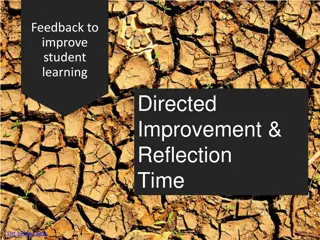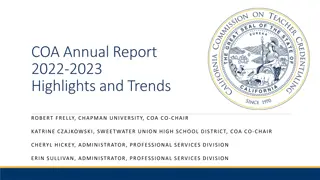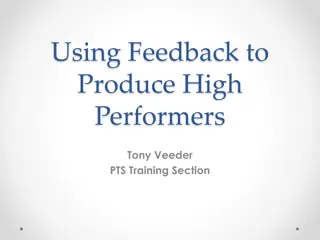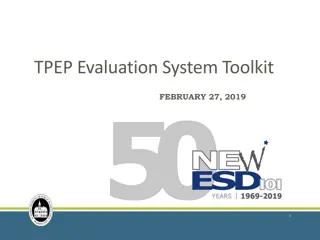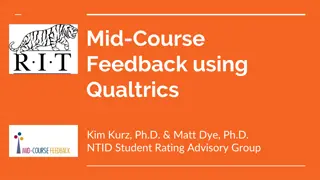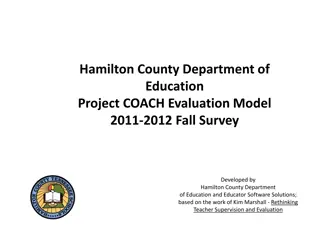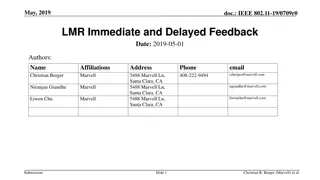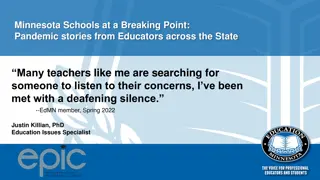Importance of Student and Staff Feedback in Educator Evaluation
Student and staff feedback plays a crucial role in educator evaluation, providing valuable insights into areas of strength and growth. Informed by evidence such as surveys, observations, and artifacts, feedback helps educators tailor their practice, fostering two-way communication and professional development. Massachusetts Department of Elementary and Secondary Education emphasizes the flexibility and significance of incorporating feedback throughout the evaluation cycle to enhance teaching efficacy. Real-life examples highlight how feedback shapes goals and communication with students, contributing to a comprehensive understanding of educators' practices.
Uploaded on Sep 23, 2024 | 1 Views
Download Presentation

Please find below an Image/Link to download the presentation.
The content on the website is provided AS IS for your information and personal use only. It may not be sold, licensed, or shared on other websites without obtaining consent from the author. Download presentation by click this link. If you encounter any issues during the download, it is possible that the publisher has removed the file from their server.
E N D
Presentation Transcript
Student & Staff Feedback in Educator Evaluation 1
Background As of 2014-15*, o Student feedback became an evidentiary component of a teacher s summative performance evaluation o Staff feedback became an evidentiary component of an administrator s performance evaluation 2 *Amended from initial regulatory timeline of 2013-14 Massachusetts Department of Elementary and Secondary Education
Evidence to Inform the Summative Performance Rating Products of Practice Artifacts Observations Multiples Measures of Student Learning Assessments (formative, summative, etc.) Student work, homework, etc. Student and Staff Feedback ESE Model Feedback Surveys Focus groups, exit slips, discussion prompts, etc.
WHY is feedback from students and staff so important? My areas of strength and growth are no mystery to my students. Opting to let students discuss my practice through an anonymous survey allowed me to use relevant evidence, while, most importantly, increasing the intangible student respect and engagement. Aaron Stone, Teacher, BPS "Two-way communication between teachers and students is a cornerstone of effective practice. I have been utilizing surveys for several years to gauge how effective different assessments or other learning activities in my classroom are. The feedback helps informs my practice. Rebecca Duda, Teacher, Dracut
WHY is feedback from students and staff so important? Informs professional growth and development Gives students and staff a voice in their experiences Contributes to a comprehensive picture of an educator s practice
WHEN do educators collect feedback? Districts have flexibility regarding how and when to incorporate feedback into an evaluation cycle o Formative o Summative o Both Massachusetts Department of Elementary and Secondary Education 6
Example: Shaping goals & communicating with students 7 Massachusetts Department of Elementary and Secondary Education
WHAT are educators using to collect feedback? Individualized instruments Common school- or district-wide instruments Combination of both 8 Massachusetts Department of Elementary and Secondary Education
Three Principles of High Quality Feedback Instruments Feedback should be aligned to one or more MA Standards and Indicators for Effective Teaching Practice or Administrative Leadership so that it yields information that is relevant to an educator s practice. Feedback should be informative and actionable. Instruments must be accessible to all potential respondents so that the information they provide allows educators to draw valid conclusions. 9 Massachusetts Department of Elementary and Secondary Education
ESE Tools & Resources ESE Model Surveys Online Option Additional Instruments & Strategies 10 Massachusetts Department of Elementary and Secondary Education
ESE Model Feedback Surveys Student Surveys (Grades 3-5 and 6-12) o Standard, Short, Mini* Staff Surveys o Standard, Short *New mini forms! 11 http://www.doe.mass.edu/edeval/feedback /surveys.html Massachusetts Department of Elementary and Secondary Education
ESE Model Feedback Surveys: Online option Individualized Use Google Templates http://www.doe.mass.edu/edeval/feedback /SSF-SingleUserAdmin.pdf 12 Massachusetts Department of Elementary and Secondary Education
Additional Instruments K-2 Discussion Prompts Adapted Model Student Survey (for students with significant cognitive disabilities) Interview/Focus Group Discussion Protocol (aligned to principles of inclusive practice) Alternative Strategies (job-embedded tools) o Classroom Suggestion Box o Exit Slips o Entrance Tickets o Letter to Next Year s Students 13 Massachusetts Department of Elementary and Secondary Education
ESE Resources Quick Reference Guide: Student & Staff Feedback Guidance on Student and Staff Feedback ESE Model Feedback Surveys & Protocols Alternative Strategies (aligned to principles of inclusive practice) Considerations for Collective Bargaining ESE/MASS Video Series and Training PPT 14 SSF Webpage: http://www.doe.mass.edu/edeval/feedback/ Massachusetts Department of Elementary and Secondary Education
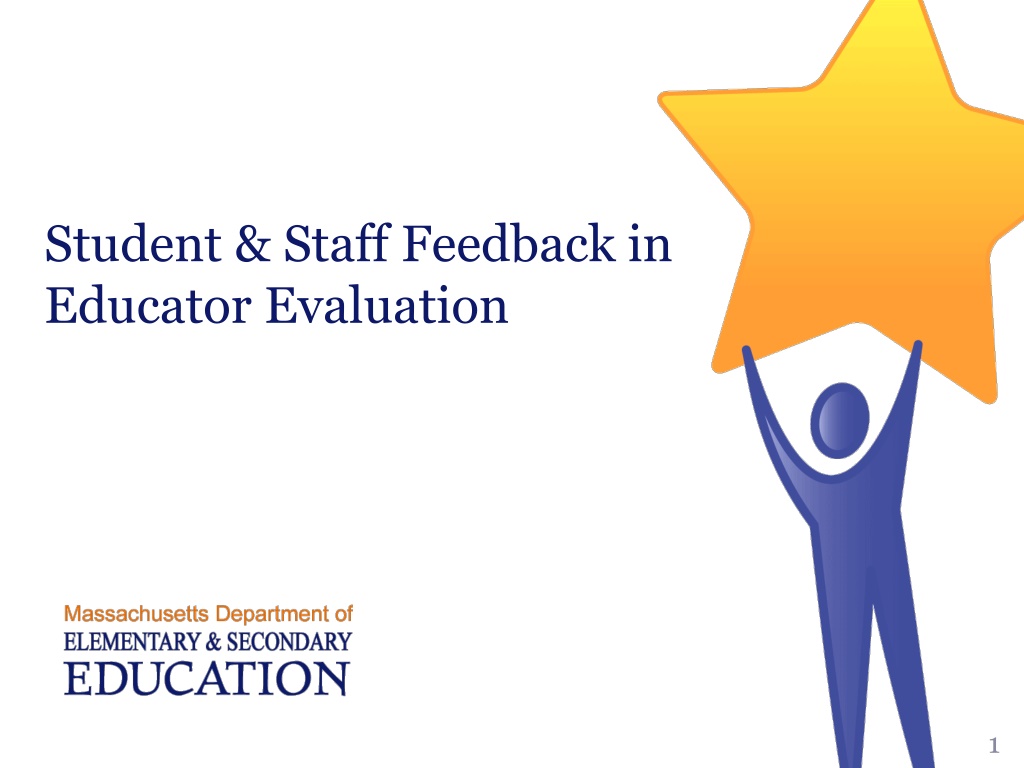
 undefined
undefined








